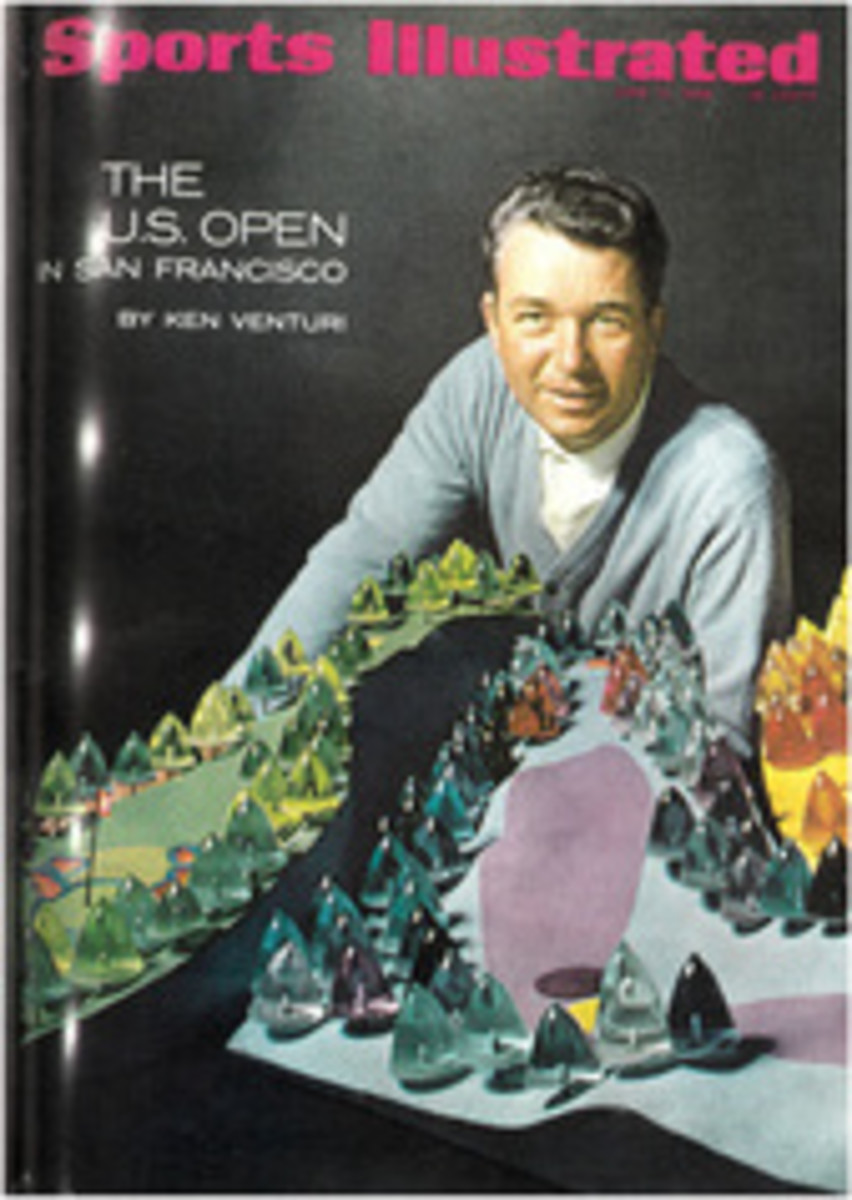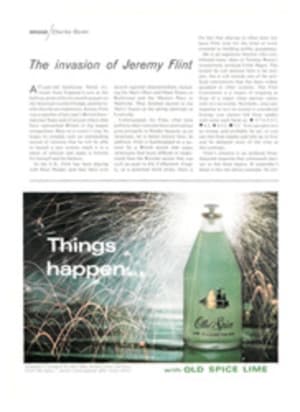
THE SECOND FASTEST EVER
"I COULD HAVE RUN THE RACE A GOOD DEAL FASTER"
Setting up world-record attempts in the mile run is like handling butterflies. The slightest miscalculation, one clumsy move, and oops! Maybe a busted butterfly, but no busted record. And so it seemed at last week's Compton Invitational Track Meet in the Los Angeles Coliseum, where a carefully prepared attempt at Michel Jazy's mile mark of 3:53.6 was foundering on a soft track and a slow early pace. Yet here came 19-year-old Jim Ryun, his hot-pink shorts and his pale-blue jersey glowing in the lights, his long legs reaching out as he hurtled like a sprinter through the final 220 yards. The timers' watches ticked on—3:53.4, 3:53.5, 3:53.6, 3:53.7—and then Ryun was through the tape. Not a world record, but easily a new American one; not a world record, but the second fastest mile ever run; not a world record, but the bright promise of a series of them to come.
Ryun was both amazed and chagrined when he heard the winning time. "I thought I'd done about 3:56," he said. "I felt so strong at the end. That really ticks me off. If I'd missed by half a second, well, that might have been all right. But to come so close and not even know I was doing it."
All week Jim Ryun had known what he was going to try to do. His coach at the University of Kansas, Bob Timmons, had called ahead from Lawrence to announce to meet officials that he felt Jim was ready for a shot at the world record. What Timmons and Ryun needed was someone to carry the field to a three-quarter time of 2:56.
"It's not so much that I need the psychological lift of being able to float along behind somebody," Ryun explained on the eve of the race. "It's just that I don't have too good a sense of pace. I'm liable to blast out the first quarter in 54 seconds and not have much left for the rest of the race. I did that indoors in New York one night. I had to work hard in the last quarter."
Well, runners who can belt out 2:56 times for the three-quarter mile are not exactly a dime a dozen, but meet officials thought they had a couple who would try. One of them was a long-tressed Englishman from Birmingham, 25-year-old Neill Duggan, a freshman at Allan Hancock College in Santa Maria, Calif. The other was the experienced George Young, who is a member, with Ryun, of the Church of Christ; although primarily a steeplechaser, he was willing to oblige. George, however, grew testy about his assignment when word got out that that was all he was to do.
"I don't like people to think that I'm just out there to set a fast early pace," he said as he loosened up with a jog around Lafayette Park across from his hotel the morning of the race. "But I can set a fast enough one to give somebody a world record. That's all that anyone wants from me, anyway. No one cares what I do after that."
Young downgraded himself more than he needed to. The people producing the Compton Invitational were used to extraordinary performances, and historically they have appreciated help from bit players who added to the luster of their meet, where 25 sub-four-minute miles had been run in 11 years. One bit player in 1964 was 17-year-old Jim Ryun. He finished eighth in a race in which Oregon's bony Dyrol Burleson outkicked Chicago's red-haired Tom O'Hara to win in 3:57.4. Ryun, only a junior at Wichita's East High School, clocked 3:59 and became the first high-school runner to get under four minutes.
Until Ryun began to make his mark in Compton's history books it was a Kansan of another era, Wes Santee, who had been the meet's most stimulating performer. Santee was the kind of man that Californians can readily understand. He was proud and sure of himself. He spoke freely of world records and sub-four-minute miles—and he almost produced. Santee ran at Compton for the first time in 1953, vowing to return to the U.S. the world mile record that another Kansan, Glenn Cunningham, had held until 1937. Whipping through the final half in 1:57.2, the tall, slender University of Kansas junior set a U.S. mile record of 4:02.4, but missed by a second the world record held by Sweden's Guilder H√§gg.
The Compton Mile in 1954 was pure Santee: bittersweet and thoroughly frustrating. For months Wes had been struggling to become the first sub-four-minute miler in track history, but only a couple of weeks earlier he had been nipped out of his place in history by England's Roger Bannister. Santee was in cracker-jack condition and primed to follow Bannister's example, if no longer able to set one himself. He needed no pacemaker. But a fast Swede, Ingvar Ericsson, was on hand to be sure that things moved briskly. They did.
Santee brought the crowd to its feet with a three-quarter time of 2:59. He swept past watches posted at the 1,500-meter mark in a world-record time of 3:42.8 and headed for the mile record 120 yards away like a fast sloop sliding downwind. Then something happened to the wind. Possibly it was the fact that a nasty little breeze was blowing into his face on the backstretch, or possibly it was simply the pain of maximum effort. All at once Santee looked more like a covered wagon than a racing sloop. It took him 17.8 seconds to negotiate the final 120 yards, and when Santee reached the finish line his legs were so tied in knots that he virtually was in a sitting position. That was as close as Kansas' last renowned miler before Ryun came to the mile record at Compton.
Part of Compton's early success was due to its dowdy high-school stadium, where the meet was held until it moved to the Coliseum in 1965. The red-clay track was one of the fastest in the country, and, though the stands held only 7,000 people, they were close to the track and created the same kind of exciting intimacy that runners encounter indoors. Eventually the spectators got so close to the field that they began to spill over it. This, plus the fact that the overflow still was not great enough to support a meet of Compton's proportions, convinced the sponsors that they should move to the 95,000-seat Coliseum.
Unfortunately, they may have made their move too late. In 1965 only 12,160 sat in on a chilly night, and last week a disappointing 10,071 were on hand. Track is not the attention-grabber it used to be in southern California.
"The professional sports are killing us," explained one sponsor. "There's so much emphasis on the big pro teams, the Dodgers, the Angels, the Rams, the Lakers, now pro hockey, that track seems to get lost."
"Track's a hard sell out here these days," says Al Franken, who does publicity for several track meets and sports events in California. "But a kid like Ryun in the mile could help it bounce back on the West Coast."
If ever there was an athlete who could make a sport popular, it is Ryun. Tall and clean-cut, sensitive and self-effacing, he is even now becoming a figure against which parents subconsciously measure their own offspring. But underneath his serene exterior there is a tough heart that makes for brilliant competition. Long before he had a right to expect such results, Ryun was digging into his deep reservoir of determination and beating runners he should have been too timorous to shake hands with. Except for his semifinal race in the Tokyo Olympics, when he was 17, Ryun has never run a bad race. He has improved each year, and there are now many who believe that he will hold every record from the half-mile through two miles, and perhaps over longer distances if he cares to try.
Ryun, briefly, is the finest middle-distance runner ever developed in this country. A few more races like the one he ran Saturday night, and promoters will be turning fans away by the thousands. In the race also was Jim Grelle, the 29-year-old miler from Portland, Ore. who had followed Ryun so closely in the Coliseum relays three weeks earlier when Ryun broke the American citizen's two-mile record. In his days as a club-mate of Jim Beatty, Grelle had been involved in several carefully staged races to produce U.S. or world records, and he was not particularly excited about this one. Where he was something of a sacrificial rabbit in those races, he was regarded as real competition at the Coliseum. He felt, in fact, that he also was capable of breaking Jazy's mark if everything worked out just so.
"I'd like to see the world record come back to the U.S.," he said the morning of the race, "but you know everything has to be just right and that doesn't happen too often."
On this particular occasion, the inside lane of the Coliseum's red, crushed-brick track was chopped up from a heavy program of earlier races. Besides, the man everybody was counting on to set a fast first quarter, Duggan, was feeling peaked from a hard week of late nights and long banquets. "I was pretty bushed," he said. "I wanted to do a 58 first quarter, but I never could get going."
He led the nine starters through the 440 in a laggard 59.7 and then Young, with Ryun sticking close behind, rushed to the front. Young was in front, too, at the half-mile in 1:58.4, and then with 660 yards to go he moved out into the second lane to let Ryun go by.
"I felt kind of tight during the first quarter," said Ryun later, "and I still felt tight during the second quarter. But when George moved over to let me by, I suddenly felt very good."
The runners could not quite hear the lap times that were shouted to them as they came by each time around, and the three-quarter clocking of 2:58.5 was disappointingly slow. Ryun, with Grelle lagging behind him, sprinted wildly through the backstretch. With 220 yards to go, he seemed to explode into another, smoother gear. He covered the distance to the finish in 26.4 and looked as though he could have kept right on flying at that startling pace. Had he started his last great kick just 20 or 30 yards sooner or had the earlier pace been just a bit brisker...
But these are not the things that concern Ryun after an all-out effort. Usually he is in a state of nauseated collapse for 30 minutes and is too weak to think or say anything. Saturday, though, he was relaxed as he strolled through the infield after learning his time. "I feel great," he said. "It kind of gives me the idea I could have run the race a good deal faster." Quiet Jim Ryun has never said anything like that before.
PHOTO
RICH CLARKSON
Alone and markedly relaxed at the finish, Ryun flows through the tape a good 20 yards ahead of his nearest competitor, Oregon's Jim Grelle.
PHOTO
RICH CLARKSON
Ryun, who shortly may become the world's best-known runner, is introduced to sparse crowd.

